| New buzz
in the Hornet family
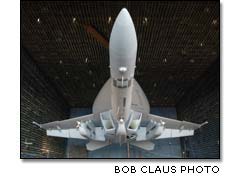 From
10,000 feet, the EA-18G looks remarkably like its cousin, the F/A-18F.
But this member of the Hornet family has a different kind of sting. The
"G," as it's called, will perform the critical airborne electronic attack
mission for the U.S. Navy's tactical aircraft fleet, jamming enemy radars
and communications to allow fighter and attack aircraft like the Super
Hornet to fly into enemy airspace virtually undetected. From
10,000 feet, the EA-18G looks remarkably like its cousin, the F/A-18F.
But this member of the Hornet family has a different kind of sting. The
"G," as it's called, will perform the critical airborne electronic attack
mission for the U.S. Navy's tactical aircraft fleet, jamming enemy radars
and communications to allow fighter and attack aircraft like the Super
Hornet to fly into enemy airspace virtually undetected.
The "G," based on the battle-proven F/A-18F airframe, will accomplish
this using a variety of electronic jammers in conjunction with sensitive
radar and communication sensors, some of which are currently on or being
developed for the EA-6B Prowler, the Navy's current airborne electronic
attack platform.
FULL STORY >>

THINKING
about the future
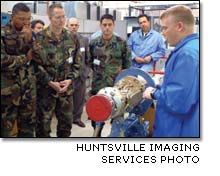 Oftentimes,
perception is very different from reality. A disinterested student is
actually a genius, or a penny-pinching person is a closet millionaire.
The same can be said for Huntsville, Ala. Oftentimes,
perception is very different from reality. A disinterested student is
actually a genius, or a penny-pinching person is a closet millionaire.
The same can be said for Huntsville, Ala.
Nestled between the foothills and cotton fields of north Alabama, Huntsville
appears to be a small town surrounded by farms. But at its center is a
haven of science and technology-a place that's a vital player in the United
States' space exploration and missile defense programs.
Huntsville hosts many leading U.S. aerospace companies-large and small-and
major U.S. government organizations including NASA's Marshall Space Center,
the Missile Defense Agency, the Army's Space and Missile Defense and Aviation
and Missile Commands, and many innovative technology developers from the
commercial sector. One of the shining stars in Huntsville is Boeing.
FULL STORY >>

Exactly where they want it to be
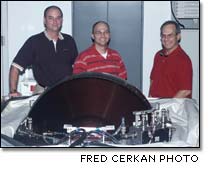 The
International Space Station has been safely orbiting the Earth these past
six years thanks in part to the Boeing Guidance, Navigation and Control
team. In November, the ISS team celebrated its sixth year of on-orbit
operations with expedition crewmembers. The
International Space Station has been safely orbiting the Earth these past
six years thanks in part to the Boeing Guidance, Navigation and Control
team. In November, the ISS team celebrated its sixth year of on-orbit
operations with expedition crewmembers.
The 29-person Boeing GN&C team supports NASA in several areas including
daily system monitoring, troubleshooting on-orbit anomalies, designing
controls to support operations and upcoming assembly flights, and improving
the system software.
The ISS has two navigation and control systems working in tandem, one
in the Russian Zvezda Service module and one in the U.S. Destiny Laboratory
module and S0 (center) Truss element. They operate simultaneously with
one designated as the master system but with both exchanging data continuously
for fault detection and redundancy. Each can navigate and control the
station's orientation or attitude, but only the Russian segment has thrusters
that can raise the altitude of the space station to overcome the decaying
effects of atmospheric drag, or to avoid orbital debris.
FULL STORY >>

'Tell us more about Lean'
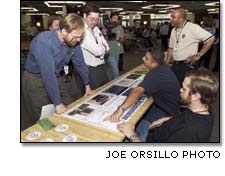 At
Boeing Satellite Systems, one good day deserves another. To help accelerate
its transformation to a Lean enterprise, BSS will hold its second Lean
Day on Jan. 26, a mere four months after conducting its inaugural Lean
Day. At
Boeing Satellite Systems, one good day deserves another. To help accelerate
its transformation to a Lean enterprise, BSS will hold its second Lean
Day on Jan. 26, a mere four months after conducting its inaugural Lean
Day.
The initial Lean Day featured a full slate of exhibits, training, and
guest speakers. About 160 leaders and change agents attended presentations
by experts from across Boeing who offered insight into how Lean is being
implemented on the C-17 Globemaster III, 7E7 Dreamliner and other programs.
Additional Lean-oriented tools and techniques used in functions and programs
at BSS were displayed at an onsite Lean exposition. All were part of the
BSS accelerated transformation to Lean operations.
FULL STORY>>

Give it a hand (or
don't)
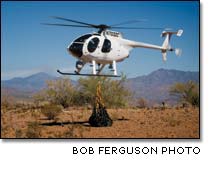 When
reporter David Harvey lifted off in October aboard the "Unmanned Little
Bird," he knew he could be in for one exciting ride. When
reporter David Harvey lifted off in October aboard the "Unmanned Little
Bird," he knew he could be in for one exciting ride.
"Outstanding, outside-of-the-box thinking," he said after the flight
in the Unmanned Little Bird, a Boeing project that combines the capabilities
of manned or unmanned flight aboard a proven MD 530F manned helicopter.
"This approach is spot-on target for future developments."
He confirmed that message to his readers at rotorhub.com and uvonline.com
a few days later, writing, "Boeing's Mesa [Ariz.] division had sufficient
confidence in their unmanned/manned MD 530F 'Little Bird' demonstrator
to fly this reporter on only its fourth autonomously guided mission."
FULL STORY >>

Lights shine on Blue Angels
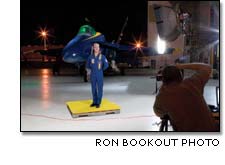 Fat
Albert never looked better. The C-130 cargo aircraft had its "formal"
portrait taken last month with key members of its crew, courtesy of the
St. Louis Boeing Creative Services team. Fat Albert, the support plane
for the U.S. Navy Blue Angels aerial demonstration team, and the team's
six blue-and-gold F/A-18 Hornets are definite crowd pleasers and draw
large audiences wherever they appear. Fat
Albert never looked better. The C-130 cargo aircraft had its "formal"
portrait taken last month with key members of its crew, courtesy of the
St. Louis Boeing Creative Services team. Fat Albert, the support plane
for the U.S. Navy Blue Angels aerial demonstration team, and the team's
six blue-and-gold F/A-18 Hornets are definite crowd pleasers and draw
large audiences wherever they appear.
With a Hornet in the background, each Blue Angels pilot-including Commander
Steve Foley-had his portrait taken for the upcoming 2005 air show season.
The Blue Angels perform their aerial shows in front of millions of spectators
each year at more than 35 locations.
FULL STORY >>

Thinking small
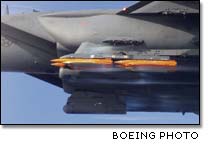 Dan
Jaspering and Don Hutcheson think a weapon flight test provokes a different
sort of tension than an aircraft flight test. Problems can't be fixed
or worked around after the weapon is "pickled," or released. Dan
Jaspering and Don Hutcheson think a weapon flight test provokes a different
sort of tension than an aircraft flight test. Problems can't be fixed
or worked around after the weapon is "pickled," or released.
"Once you let go, all you can do is watch," said Jaspering, Small Diameter
Bomb program manager for Boeing Integrated Defense Systems. "An SDB will
fly anywhere from six to 12 minutes, and we joke about never realizing
we could hold our breath that long."
The anxiety of Hutcheson, the program's business development lead, and
Jaspering seems unnecessary in view of the program's record, but it's
one more sign of the energy and innovation going into the development
of the Small Diameter Bomb system. With a potential worth of over $2 billion
for Boeing, the system will increase the efficiency of military aircraft
by allowing them to carry more weapons, thus enhancing mission effectiveness.
FULL STORY >>
|

